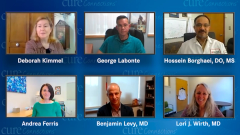
Molecular Testing in Thyroid Cancer: Interpreting Results
Lori J. Wirth, MD, describes what information she looks for from results of molecular testing that help inform treatment for her patients with thyroid cancer.
Episodes in this series

Hossein Borghaei, DO, MS: Dr. Wirth, let me come back to you. When you get a biomarker report, what kind of information is typically included? I know your center specifically, but could you talk in general? What is it that you’re looking for, and how do you communicate that with your patient regarding what’s on the report?
Lori J. Wirth, MD: In our center, our biomarker testing generally comes in two separate reports. We have a fusion assay that’s reported separately from the mutational assay. Our report basically spells out when it was done, who did the testing, and highlights if there are any actionable alterations that are found and what they are. If no actionable alterations are found, it will state that too. If there’s a variant of uncertain significance, that will be stated as well. Then there are a couple of pages with all the different genes that have been tested. The reports are long and can be difficult to read through, especially for a lay person, and understand. Now that all our electronic medical records are immediately available to patients, often patients have looked at the results before their clinic visit. It’s such an unfortunate circumstance because they’ve seen the report, yet there’s so much information there that it’s hard to know what all the words mean. These reports that are difficult to understand can generate a lot of anxiety while the patient is waiting for the doctor’s visit to go through the results with them.
Hossein Borghaei, DO, MS: Specifically, what do you look for in the report? You’re actually looking at everything that’s in that report, not just one alteration to decide treatment immediately? You actually go through the whole report and discuss all that with your patient to provide as much context and information as possible, correct?
Lori J. Wirth, MD: Yeah. In our molecular diagnostics reports in thyroid cancer, Some mutations are found that can indicate a cancer may be a little more aggressive, whereas the absence of those co-mutations suggests perhaps a more indolent disease. We’re looking at that information in addition to whether or not a BRAF V600E mutation or a RET fusion is there, for example. There are other mutations in genes such as TER, TOR, TP53. We put all that information together, along with the information from the pathology and the histology, the outcomes of the surgery, the disease state in terms of what we’re seeing on CT scans or MRIs, what the tumor markers are, and how the patient feels. It’s a lot information to integrate, and it’s important for us to go over all those aspects of the data we have with the patients, to explain what that means about what we expect about this cancer, how it might be behaving going forward, and what we can try to do about it.
This transcript has been edited for clarity.






